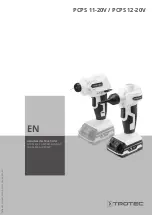
AE4-1322
© 2002 Copeland Corporation
Issued 4-2002
Printed in U.S.A.
21
Data for accessories and oil charge
Data for accessories and oil charge
Data for accessories and oil charge
Data for accessories and oil charge
Data for accessories and oil charge
•
Oil heater: 115/230 VAC
SCH2 5000 to 9000
200W
SCA2 3500 to 7000
SCH2 11H0 to 14H0 300W
SCA2 9000 to 11H0
•
Capacity control:
24/115/230 VAC 50/60 Hz
•
Oil charge:
Solest170 for R134a, R407C, R404A and R507A
CP4214-320 for R 22
Oil heater
Oil heater
Oil heater
Oil heater
Oil heater
Ensures the lubricity of the oil even during long stand-
still periods. It prevents increased refrigerant dilution
into the oil and therefore reduction of viscosity.
The oil heater must be used during the shutdown for
•
outdoor installation of the compressor (insulate the
oil separator additionally if necessary)
•
long off cycles
•
high refrigerant charge
•
danger of refrigerant condensation into the
compressor
10 Performance data
10 Performance data
10 Performance data
10 Performance data
10 Performance data
For detailed compressor selection with the option of
individual data input our selection software is available
as CD-ROM or can be downloaded from our internet
web site. The resulting output data include all impor-
tant performance parameters for compressors and
additional components, application ranges, technical
data and dimensional drawings. Moreover, specific data
sheets can be generated which may either be printed
out or transferred into other software programs, such
as Excel, for further use.
Basic parameters
Basic parameters
Basic parameters
Basic parameters
Basic parameters
Evaporating and condensing temperatures correspond
to “dew point” conditions (saturated vapor). With
zeotropic blends like R407C this leads to a change in
the basic parameters (pressure levels, liquid tempera-
tures) compared with data according to “intermediate
temperatures” used so far. As a consequence this
results in a lower numerical value for cooling capacity
and efficiency (COP).
Liquid sub-cooling
Liquid sub-cooling
Liquid sub-cooling
Liquid sub-cooling
Liquid sub-cooling
With standard conditions
no
no
no
no
no
liquid sub-cooling is
considered. Therefore the rated cooling capacity and
efficiency (COP) show lower values in comparison to
data based on 9 or 15°F of sub-cooling.
Economizer operation
Economizer operation
Economizer operation
Economizer operation
Economizer operation
Data for economizer operation system inherently
include liquid sub-cooling. The liquid temperature is
defined as 18°F above saturated temperature (dew
point with R407C) at economizer inlet (t
cu
= t
ms
+
18°F).
10.1 Compressor selection by software
10.1 Compressor selection by software
10.1 Compressor selection by software
10.1 Compressor selection by software
10.1 Compressor selection by software
•
Select the menu CSH Compact Screws.
•
Type the desired Cooling Capacity.
•
Select desired operating conditions:
-Refrigerant and for R407C
-Reference temperature
-Evaporating temperature
-Condensing temperature
-Without or with economizer
-Liquid Sub-cooling
-Suction Gas superheat or suction gas temp.
-Useful superheat
-Power supply
•
Hit Calculate.
In the window Output Data the selected compres-
sors with performance data are shown (fig. 24).
•
Data output:
At this stage an input of individual text (Head line)
is possible.
- Print: Print-out at standard printer, with
application limits (application ranges)
- Export: Output as ASCII file
10.2 Finding compressor performance data using
10.2 Finding compressor performance data using
10.2 Finding compressor performance data using
10.2 Finding compressor performance data using
10.2 Finding compressor performance data using
the software
the software
the software
the software
the software
•
Select the menu CSH Compact Screws.
•
Select Compressor Type.


































